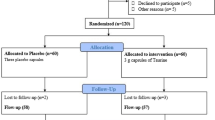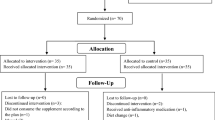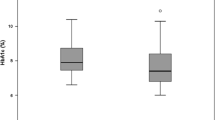Abstract
Post-prandial hyperglycemia seems to play a pivotal role in the pathogenesis of the cardiovascular complications of diabetes mellitus, as it leads to an oxidative stress which in turn causes a reduced NO bioavailability. These conditions produce an endothelial activation. Aim of the study: The aim of this study was to assure that the administration of N-acetylcysteine (NAC), thiolic antioxidant, is able to decrease the oxidation status and endothelial activation after a high-glucose content meal. Subjects and methods: Ten patients with Type 2 diabetes mellitus (DMT2) (Group 1) and 10 normal subjects (Group 2) were studied. They assumed a high-glucose content meal without (phase A) or after (phase B) the administration of NAC. Glycemia, insulinemia, intercellular adhesion molecule 1, vascular adhesion molecule 1 (VCAM-1), E-selectin, malonaldehyde (MDA), and 4-hydroxynonenal (HNE) were assessed at −30, 0, +30, +60, +90, +120, and +180 min with respect to the meal consumption. Results: During the phase A in Group 1, only HNE and MDA levels increased after the meal assumption; all parameters remained unchanged in Group 2. During the phase B, in Group 1, HNE, MDA, VCAM-1, and E-selectin levels after the meal were lower than those in phase A, while no change for all variables were observed in Group 2. Conclusions: A high-glucose meal produces an increase in oxidation parameters in patients with DMT2. The administration of NAC reduces the oxidative stress and, by doing so, reduces the endothelial activation. In conclusion, NAC could be efficacious in the slackening of the progression of vascular damage in DMT2.
Similar content being viewed by others
References
Buse JB, Ginsberg HN, Bakris GL, et al; American Heart Association; American Diabetes Association. Primary prevention of cardiovascular diseases in people with diabetes mellitus: a scientific statement from the American Heart Association and the American Diabetes Association. Circulation 2007, 115: 114–26.
Glucose tolerance and mortality: comparison of WHO and American Diabetes Association diagnostic criteria. The DECODE study group. European Diabetes Epidemiology Group. Diabetes Epidemiology: Collaborative analysis Of Diagnostic criteria in Europe. Lancet 1999, 354: 617–21.
Bonora E, Muggeo M. Postprandial blood glucose as a risk factor for cardiovascular disease in Type II diabetes: the epidemiological evidence. Diabetologia 2001, 44: 2107–14.
Ceriello A. The emerging role of postprandial hyperglycaemic spikes in the pathogenesis of diabetic complications. Diabet Med 1988, 15: 188–93.
Napoli C, Ignarro LJ. Nitric oxide and atherosclerosis. Nitric Oxide 2001, 5: 88–97.
Yetik-Anacak G, Catravas JD. Nitric oxide and the endothelium: history and impact on cardiovascular disease. Vascul Pharmacol 2006, 45: 268–76.
Martina V, Bruno GA, Trucco F, et al. Platelet cNOS activity is reduced in patients with IDDM and NIDDM. Thromb Haemost 1988, 79: 520–2.
Friebe A, Koesling D. Regulation of nitric oxide-sensitive guanylyl cyclase. Circ Res 2003, 93: 96–105.
Ignarro LJ, Edwards JC, Gruetter DY, Barry BK, Gruetter CA. Possible involvement of S-nitrosothiols in the activation of guanylate cyclase by nitroso compounds. FEBS Lett 1980, 110: 275–8.
Beckman JS, Koppenol WH. Nitric oxide, superoxide, and peroxynitrite: the good, the bad, and ugly. Am J Physiol 1996, 271: C1424–37.
Yano M, Hasegawa G, Ishii M, et al. Short-term exposure of high glucose concentration induces generation of reactive oxygen species in endothelial cells: implication for the oxidative stress associated with postprandial hyperglycemia. Redox Rep 2004, 9: 111–6.
Ceriello A. Postprandial hyperglycemia and diabetes complications: is it time to treat? Diabetes 2005, 54: 1–7.
Martina V, Bruno GA, Zumpano E, Origlia C, Quaranta L, Pescarmona GP. Administration of glutathione in patients with type 2 diabetes mellitus increases the platelet constitutive nitric oxide synthase activity and reduces PAI-1. J Endocrinol Invest 2001, 24: 37–41.
Martina V, Masha A, Gigliardi VR, et al. Long-term N-acetylcysteine and L-arginine administration reduces endothelial activation and systolic blood pressure in hypertensive patients with type 2 diabetes. Diabetes Care 2008, 31: 940–4.
Tsuchida M, Miura T, Mizutani K, Aibara K. Fluorescent substances in mouse and human sera as parameter of in vivo lipid peroxidation. Biochim Biophys Acta 1985, 834: 196–204.
Ceriello A, Falleti E, Motz E, et al. Hyperglycemia-induced circulating ICAM-1 increase in diabetes mellitus: the possible role of oxidative stress. Horm Metab Res 1998, 30: 146–9.
Brownlee M. Biochemistry and molecular cell biology of diabetic complications. Nature 2001, 414: 813–20.
Moncada S, Radomski MW, Palmer RM. Endothelium-derived relaxing factor. Identification as nitric oxide and role in the control of vascular tone and platelet function. Biochem Pharmacol 1988, 37: 2495–501.
D’Acquisto F, Maiuri MC, de Cristofaro F, Carnuccio R. Nitric oxide prevents inducible cyclooxygenase expression by inhibiting nuclear factor-kappa B and nuclear factor-interleukin-6 activation. Naunyn Schmiedebergs Arch Pharmacol 2001, 364: 157–65.
Baldwin AS Jr. The NFκB and IκB proteins: New discoveries and insights. Annu Rev Immunol 1996, 14: 649–83.
Marui N, Offermann MK, Swerlick R, et al. Vascular cell adhesion molecule-1 (VCAM-1) gene transcription and expression are regulated through an antioxidant-sensitive mechanism in human vascular endothelial cells. J Clin Invest 1993, 92: 1866–74.
Author information
Authors and Affiliations
Corresponding author
Rights and permissions
About this article
Cite this article
Masha, A., Brocato, L., Dinatale, S. et al. N-acetylcysteine is able to reduce the oxidation status and the endothelial activation after a high-glucose content meal in patients with Type 2 diabetes mellitus. J Endocrinol Invest 32, 352–356 (2009). https://doi.org/10.1007/BF03345726
Accepted:
Published:
Issue Date:
DOI: https://doi.org/10.1007/BF03345726




